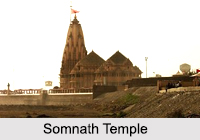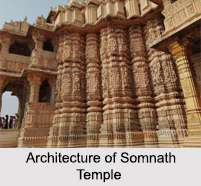 Located in the western coast of Gujarat near Veraval in Saurashtra, the Somnath Temple is dedicated to Somnath, who is the protector of the Moon God. There are notable mentions of the temple in the Rig Veda as well. It has been said that people from the remotest parts of the country came to worship at the Somnath Temple. Somnath rose and fell many a time, and the present site of the Somnath Temple, is a pile of ruins. With constant desecration and reconstruction, the Hindus finally built a new temple nearby.
Located in the western coast of Gujarat near Veraval in Saurashtra, the Somnath Temple is dedicated to Somnath, who is the protector of the Moon God. There are notable mentions of the temple in the Rig Veda as well. It has been said that people from the remotest parts of the country came to worship at the Somnath Temple. Somnath rose and fell many a time, and the present site of the Somnath Temple, is a pile of ruins. With constant desecration and reconstruction, the Hindus finally built a new temple nearby.
Etymology of Somnath Temple
The name Somnath means "Lord of the Soma" or the Chandra or lunar deity, who is an epithet of Lord Shiva. The Somnath Temple is known as the Shrine Eternal and is considered sacred due to the various legends associated to it.
Legend of Somanth Temple
As per ancient legends, it is said that the moon God Chandra, possessed with arrogance for his divine features, was cursed to wane by his father-in-law Daksha, who was one of the Prajapatis and the son of Aditi and Lord Brahma. With great devotion Chandra prayed to Lord Shiva at the Prabhas tirth, who in turn removed the curse partially, thus causing the periodic waning of moon. It has also been said that the Somnath Temple was first built with gold by Moon God, with silver by Ravana, with sandalwood by Lord Krishna and with stone by Bhimdeva, the Solanki ruler of Gujarat. The construction of the present day temple began in 1950. It is the 7th temple built to commemorate the grandeur of Lord Somnath who was also known as Bhairaveshwar in the Satya Yug, Sharavanikeshwar in the Treta Yug and Shringaleshwar in Dwapara Yug.
 History of Somnath Temple
History of Somnath Temple
The history surrounding the Somnath temple is quite vague and is believed that the first temple existed before the advent of the Christian era. The next temple at the site is believed to have been erected by the Valabhi kings in about 480-767 A.D. In 725 A.D, Junayad, the Arab governor of Sind, sent his regiment to destroy the second temple. The Pratihara king Nagabhata II constructed the third temple in 815 A.D from a large structure of red sandstone. The destruction wrought upon this temple by Mahmud of Ghazni in 1025 A.D. is an important event in history. In his blind fury, not only did he spoil an object of beauty but also tore up the pages of history which Somnath bore on its walls. It is said that the tern pie was supported by pillars which bore the name of its embellisher, which history has lost forever. The history of the Somnath Temple is punctuated with episodes of destruction and reconstruction at various points of time in the 14th, 15th and 16th centuries. Finally the temple was once again ruined in 1706 A.D by Mughal Emperor Aurangzeb. After that more than 200 years passed before Sardar Vallabhbhai Patel finally took upon himself the responsibility of constructing it once again in the year 1947. Much to the glory and pride of not just Somnath but of the whole of India this stunning temple was once again restored to its former glory.
Architecture of Somanth Temple
In its external design the Somnath Temple compares well with the temple of Rudramala at Siddhapur and is more or less of the same length. The dome, however, is as large as any other built in this period. The temple faces east and had an enormous central hall with three entrances, each protected by a lofty porch. The fragments that lie scattered at a short distance from the site give same idea of the sculptured decoration of the temple. The richly carved doorways, the sculptured representations of Nandi, Shiva`s bull and the figures of goddesses and their female attendants, must once have presented a plastic ensemble of great beauty. In the recesses of the balconied corridor, there is a mutilated form of Shiva Nataraja. Though essentially a Brahman dominated temple, the influence of Jain architecture is clearly discernible.
The present temple, Kailash Mahameru Prasada, is built in the style of architecture in Chalukya dynasty and indicates the skill of the Sompuras, Gujarat`s master masons. The apex of the temple rises to a height of 155 feet. There is a kalash or a pot vessel at the top, which measures 10 tons. The flag mast on this pinnacle is 37 feet long and is changed thrice during the day. The temple is situated at such an extraordinary place that there is no land in between from Somnath seashore to Antarctica. Such an inscription in Sanskrit is found on the arrow-pillar erected on the sea-protection wall at the Somnath Temple.
Visiting Information on Somnath Temple
The Veraval Railway Station is the closest at a distance of 6.4 km from the Somnath Temple and the Keshod Airport, Gujarat is at a distance of 64 km from the temple.











